Witamy na naszej stronie
Jesteśmy firmą działającą już od 1976 roku. Wszystkie nasze działania oparte są o nasze uzyskane patenty.
Główne nasze prace to ochrona środowiska. Są to opracowania autorskie, wdrożone do produkcji, za które otrzymaliśmy wiele nagród i wyróżnień.
czytaj więcej
The IZOLING
Izoling
In short
The IZOLING® composition is a neutral substance that is not harmful to the environment. The unique features of the IZOLING® "artificial soil" can be assessed by comparing it with the so-far used traditional methods.
From the mid-eighties we have been conducting research work on repeated utilization of recycling raw materials, including fibre materials of organic origin contained in the communal waste.
Contents
- Introduction
- The composition of Izoling
- The application of Izoling in its basic form
- The application of Izoling in its reclamation form
- The reclaimation method for slime waste areas
- Manner of storage of waste material from plastic
- Technical specification
- The advantegeous features of izoling
- Extras
Introduction
From the mid-eighties we have been conducting research work on repeated utilization of recycling raw materials, including fibre materials of organic origin contained in the communal waste. The research works succeeded in developing the following patent-covered technological processes:
- Producing of the IZOLING® composition for covering the communal waste
- Biological activation and supplementing of the IZOLING® composition in such a way that it play the role of a universal land reclamation materia
A method of technical application of the IZOLING® composition that offers a possibility of effective reclamation of slime sedimentation pits, standstill and other residual refluxes.
The IZOLING® composition is a neutral substance that is not harmful to the environment. The unique features of the IZOLING® "artificial soil" can be assessed by comparing it with the so-far used traditional methods.
In an overwhelming majority of the dumping facilities, in their operating technology, used as the cover material is sand, earth, their mix or another inert non-organic material suitable for that purpose.
The communal waste should be carefully covered with a layer of about 30 cm thickness.
That layer thickness of allows for normal traffic of transport means to be possible over the surface.
The cover layer plays a very functions in making a barrier for percolation waters, and also prevents the nesting of insects and rodents.
As a rule, the quantity of inert material used is 1/5 of the amount of communal waste deposited in the dump site.
This means in practice that 20 % of the valuable capacity of the dumping facility is covered by the inert material which, in most cases, must be often delivered from distant places.
That situation influences the potential reducing of storage capacity of dump sites, as well as results in making the services related to waste dumping more expensive.
Also known is the method of covering dumped communal wastes with synthetic foams distinguished for their properties of solidifying in a relatively short time.
An example of such compound is a urea- form - aldehyde foam.
Considered as a drawback of usage of the foam compounds can be a low mechanical strength, since under the load of transport means they tend to undergo crushing.
However, the principal reason for a very limited usage of those compound are extraordinary high costs.
The composition of Izoling
The IZOLING® includes in its contents from 20 to 80 per cent, by weight, of disintegrated scrap paper, from 10 to 70 per cent, b.w., of disintegrated textiles and natural and artificial fibres, from 4 to 40 per cent, b.w., of water and from 1 to 5 per cent, b.w., of disinfection agents. The compound is additionally enriched with adsorption agents in the amount of 5-30 per cent.
Izoling in its basic form A valuable advantageous feature of IZOLING is the using for its production of waste(scrap) material that finds its way to the dump site. The compound is easy to be produced in direct neighborhood of the dump site. It is, however, assumed that a selective collection of waste materials will be conducted and some of them, as for instance a dirty scrap paper, dirty rags and other fibre material, will be recovered at the garbage deposition place. It is an essential "entry" into the so much-desired recycling system. In its land reclamation modification IZOLING may contain seeds, especially those of grass, or vegetative parts (root cuttings) of some plants including -a fertilizer mix that is indispensable for their growth. In still another modification added to the substance can be hardening agent in the amount of several to several dozen per cent. The greatest advantage is that the basic material for production of the compound has previously been disposed of in the dump site as waste.
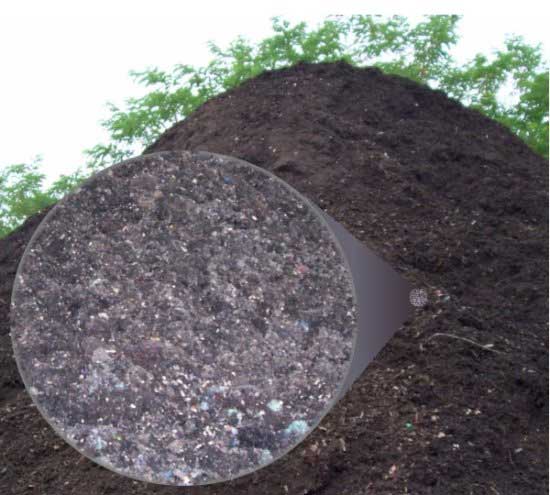
Rys. 1. Izoling in its basic form
The application of Izoling in its basic form
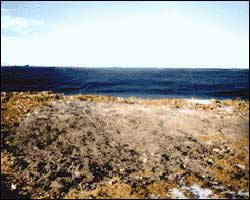
Rys. 2. Izoling composition
in dump site
The IZOLING pulp can be used as:
- the inert material for separation of the daily batch of waste,
- the material used for filtration and absorption of the emitted unpleasant smells.
The IZOLING compound, patented in its original form as an inert material for garbage dump sites, can be produced from dirty scrap paper (20-80% of mass by weight), any kind of rags and fibre material (10-40% of mass by weight) and other textiles - also the artificial ones.
Izoling composition in dump site After mixing with water and supplementing with disinfection and smell-absorbing agents the composition can be spread, in liquid form, to cover the daily batch of garbage deposited. It proves perfect in this form, it closely adheres to the base, absorbs the exhalations of the garbage bed (hydrogen sulfide, mercaptan) and it resists washing away from steep places - so much on account of susceptibility to felting as well as the presence of negligible quantity of artificial non-degradable fibres that integrate the cellulose pulp being already in a process of biodegradation under the action of saprophytic bacteria and fungi.
The application of Izoling in its reclamation form
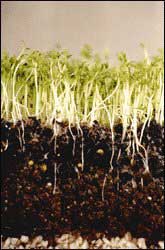
Rys. 3. Slime from river water
treatment station
In that form IZOLING can be applied as:
- a soil-making material, after adding seeds or root cuttings into the composition used for reclamation of such land areas as those of
- - communal dump sites
- - final reclamation rocky waste lands
- - sand-gravel waste lands
- - slime-type waste land
- - clayey steep slopes
- - post-industrial lands with varying pH (e.g. spoil heaps)
- a rolled meadow (on a wire net)
- decorative shaped pieces to be applied in composing a minor "architecture".
In its basic form, the IZOLING composition is not suitable for reclamation of post-industrial lands, in a broad sense of the term for it is short of a grain-like structure that allows for sprouting seeds and development of plants roots.
Slime from river water treatment stationTo make it possible, introduced in the composition, in variable quantities (depending on application), are supplementary ingredients that add to unvowen fabric - firstly - some features comparable to those of medium grade soil layer, and - secondly - properties stabilizing the reaction of the base, in a narrow pH interval, by adding moderators; thirdly - also plants' seeds of a very tough condition, with pioneer features adopted to the specific land areas (a specific set of seeds for steep slopes, another one for sandy area, and still another for reclamation of rocky surfaces or for waterlogged sites, or else - for making a 'self-fertilizing meadow', with presence of papilionaceous plants, etc.).
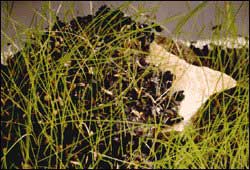
Rys. 4. Rocky base with considerable
inclination (30 degrees)
To make the IZOLING composition work in the function of soil, irrespective of having the natural hygroscopicity and disinfection substance additives, it should be enriched with a , colloidal adsorber which, owing to its capability of swelling, shall bind the remaining base ingredients to form a uniform mass and provide the required grain-like feature for the base; this will make voids to appear that may get filled partly with water and with indispensable air.
The recipe of IZOLING provides for the application of defibred scrap paper, textile fibres, the disinfection agent as well as the neutralizer of volatile humus acids; possibly - also an activator of enzymes, produced by bacterial strains and attainable for plants roots, having optimal composition, enveloped and forming aggregations - colloidal artificial fertilizers. The seeds of plants are used, in general, in a quantity of 50-80 kg/ha, while their proportions must be chosen individually for each base with taking into account of the environmental factors. There remains a question of the so-called 'biological starter' - a strain or strains of bacteria to be selected separately, depending on the place of destination, and the quantity required is determined in relation to 1 m 3 of the base substance. Rocky base with considerable inclination (30 degrees) The bacteria strains are applied in the form of so-called bio-activators with sticking to the principle that a greater quantity speeds up the decaying process, but this is not a 'measure of quality' - the faster does not mean the better. It should be strongly emphasized that, in individual cases, the reclamation composition ingredients must be selected individually, depending on the place of destination and with taking into account all the environmental data: water-logging condition, aeration, kind of base undergoing the reclamation and its reaction, as well as the inclination and light intensity of a possible slope area.
Depending on the requirements, there is also a possibility of reinforcing the cover mass, by adding minor or considerable amounts of fertilizers, absorbers, enhanced moderators, and enhancing the species range of plants.
The reclamation method for slime waste areas
The slime pits are, as a rule, difficult sites for land reclamation. For in no way can be applied the universal conventional method, when the contents of individual salts in the slime vary (depending on the origin of slime),and the permissible rates, as a rule, are surpassed, including the heavy metal contents.
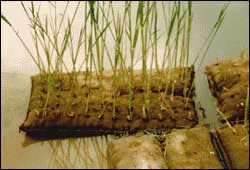
Rys. 5. Growing of plain reed
on Izoling floating mats
Besides, the slime is not often oxygen-stabilized. In addition, it is almost a rule that the thick slime fraction settles at the bottom and on top water spreads all over. Even if the slime sediment is thick over its whole thickness the sod formation on such a surface with conventional sowing is not effective.
Instead, surprisingly good results can be obtained by covering the slime surface with IZOLING mats with inserted root cuttings of hemp wattle and plain reed. Those mats, are stabilized with openwork-type viscose covering. Growing of plain reed on Izoling floating matsThey can be tacked to each other and anchored with holders to the bank to prevent their displacement by wind over the water surface.
From a set of plants for waterlogged areas (macrophytic) especially suitable for so-planned reclamation is the hemp Wattle (Salix viminalis), owing to its fast growing and ability for development in difficult oxygen conditions, as well as the plain Reed (Phargamites austratis) for its capability of malting oxygen micro-zones inside the slime mass after the mats have been overgrown with plants. Besides, the reed is known for its capability of dewatering the sediments and removing from the slime any surplus of nitrogen and phosphor compounds, as well as accumulating the trace elements, including the toxic lead, cadmium, zinc and, even mercury.
In this method of slime reclamation wattle root cuttings 15-20 cm in size, are inserted mechanically in the mat prior to covering with a viscose net. With a considerable layer of water on top of the slime (atmospheric precipitation) the IZOLING mats settle down on the base upon soaking with water and the plant material overgrows the base on the instant. It is required to apply 1500-2000 root cuttings per 100 m 2 of the waste land area. In specific cases, when the water layer over the slime remains unchanged for a long time, the IZOLING mats with "viscose blanket" cab be enriched with isoprene pellets that facilitate the maintaining of mat on the surface. in such a case the reed runners, after overgrowing, slowly 'anchor' (take root) in the slime and a process of successive vaporization of residue water pools begins.
Manner of storage of waste material from plastics
On special attention will deserve possibility of utilization of technological line IZOLING to crumbling practically all waste material on dumping ground from plastics.
This are these waste material, which occupy considerable volume of dumping ground, and at present quantity grows their.
Object of invention is manner of storage these of waste material, not being suitable to processing at today's technologies and of economic bill.
Sorted and crumbled waste - plastics used to fulfilments of containers absorbing sound placed at highways.
Possess high of meltings absorptions of acoustic energy.
Simultaneously exists possibility repeated industrial their utilizations.
Because containers absorbing sound placed are at ways, dissolved is also problem easy of further transportation on place final their utilizations.
Shape and manner of distribution of containers absorbing sound is dependent on from conditionses technical and of aesthetical values which one wants oneself to obtain.
Technical specifications
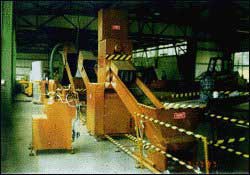
Rys. 6. Izoling - technological line
The base-material for production of IZOLING are wet cardboard, newspaper scrap material, rags, beverage cardboard Packing - the material that is not suitable for conventional recycling.
The technological line constitutes a set of machinery and equipment that enable not only the production of IZOLING composition from a combination of cellulose and textiles fibres found in communal waste, but also, a per a simple modification, it becomes a high-capacity system or disintegration and pulverization o any plastics materials, such as Pet bottles, packing and other This also radically reduces the bulk volume of waste and considerably influences the costs of handling /transportation/ and dumping.
Izoling - technological line The technological line ensures a highly efficient process and uniformity of grinding, as well as the obtaining of required grain size depending on the screen mesh. With a dry plastics material the discharge of product is performed without any pollution or dusting, directly to a bag through an extractor fan, while with the wet plastics the product is discharged directly onto the conveyor belt.
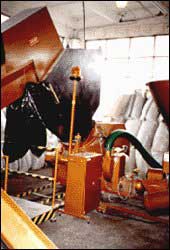
Rys. 7. Izoling
technological line
The discharge arrangement is provided with a bag deaerator and air-tight fastening of the bag which allows for an additional operation of replacement of the full container without any interruption in operation of the mill. The mill unit does not require to be fixed to the base; it can be p I a c e d on a n y properly h a r d e n e d s u r f a c e. The unit is provided with a dust-extraction cyclone which makes possible separation of the dust fraction from the properly ground product of the required grain size. It may operate in conjunction with an in-line primary crusher of plastics as well. Owing to the arrangement of a stable control cubicle system, not joined to the mill unit in a rigid manner, the cubicle can be put by the operator in any suitable place. The mass ground is delivered to a mixer which makes it uniform and enriches it with the required ingredients, depending on the application, such as absorbers, disinfection agents, fertilizers, Plant seeds and others. I The mass is collected in the container and the stub pipe, to which a suction-forcing pump is attached, allows for introducing the pulp in a cistern. With the use of a similar pump, the ready-made mass is spread over the waste dump or waste land site by splashing. Depending on the demand for the IZOLING composition the production line capacity can be increased at Customer's option. The IZOLING technological line system allows for rearrangement in 10 min., thus, offering a possibility of processing of all the plastics materials found in the dump - the plastics boxes, car fenders, beverage bottles, etc.. The ground product finds application in road construction.
The advantageous features of Izoling
The IZOLING composition is at present the cheapest material that protects the wastes and, at the same time, stimulates the selective gathering of wastes. Besides, enriched with seeds or root cuttings, the IZOLING allows for quick reclamation of numerous waste areas the reclamation of which with the conventional method (fertilizing the humus) has been not only expensive but often made difficult or impossible altogether due to washing the soil away, e.g. from the slope of spoil heaps, and to difficulties with seeding in the slime, both because of the water-soil condition and for lack of the right technology.
The greatest advantage o the "IZOLING" reclamation composition is not only the act that it has originated from wastes but that - after enrichment with appropriate absorbers, mineral or organic fertilizers, also with a possible bacterial strain, to macerate the cellulose, and with moderators - it proves to be a perfectly universal reclamation material or versatile application. It allows or an unusually quick covering with greenery and restoring or the natural environment simply vast areas, so far useless (awaiting their chance), such as spoof heaps, post-mining pits/workings, cut slopes, slime deposition sites, etc.
This offers a chance or a quick and unusually cheap making a lawn in the lot beside a house and in places with strange land configuration that so far have presented an ugly view in the environment, e.g. the post-building debris. The application of the composition brings about economic effects that count and allows for obtaining an additional dumping capacity by reducing the inert layer thickness and previous using the dumped waste material for production of the composition.
Izoling another informations
Preess
Look atthis link
Short films about IZOLING®
Documentations
Internet
- Alternatywne metody prowadzenia gospodarki odpadami (.doc)
- Przedsiębiorstwo Wielobranżowe IZOLING
- Technology of reclamation based on the resources from the recycling of municipal wastes
- Polska technologia recyklingu odpadów komunalnych (.doc)
- Przedstawiamy dwa opracowania polskie, które zdobyły prestiżowe nagrody
- LIDER POLSKIEJ EKOLOGII
- technologia "Izoling" prowadząca do. zmniejszenia objętości wysypisk śmieci (.pdf)
- REALIZACJA USTAWY O ODPADACH W POWIECIE I GMINIE
- Nominowani w III edycji konkursu ekologicznego - "Przyjaźni Środowisku"
More about IZOLING:
- Please contact mgr inż. Ryszard Hadrian tel.(+48 32) 20 35 460.
- Send us the question
Wszelkie prawa zastrzeżone © Izoling-Akam Sp. z o.o. | Wykonanie jusnet.pl
